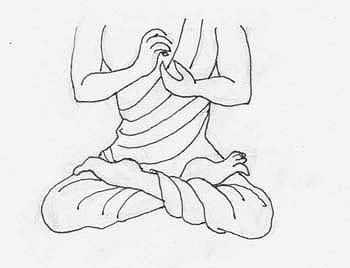|
||
 |
||

@
(C)2001 Japanese Architecture and Art Net Users System.@No reproduction or republication without written permission.
fΪΜeLXgEΚ^ECXgΘΗASΔΜRecΜ³f‘»E]ΪπΦΆά·B
|
||||||
| @ | ||||||
| kekka fuza@ζζζεΏ | ||||||
| KEY WORD :@art history / sculptures | ||||||
| @ | ||||||
| Also zenka fuza SζζζεΏ, or abbreviated to zenkaza SζζΏ, kafuza ζζζεΏ, kaza ζζΏ. The full-lotus position; the seated, meditation posture of a Buddhist image. Both legs are folded such that the tops of the feet firmly rest on the thighs of the opposite legs. Many Buddha *nyorai @ and bodhisattva *bosatsu μF images maintain this position and it is considered to be the most stable posture for meditation. There are two types of full-lotus position: kisshouza gΛΏ (the seat of good fortune), in which left foot rests on the right thigh and the right foot is folded on top and placed over the left thigh, and goumaza ~Ώ (the demon-subduing seat), in which the feet are reversed with the left leg on top, resting on the right thigh. In many cases the hands of an image in the full-lotus position rest in the lap in the *zenjou-in Tθσ (a hand position with palm open). The position of the hands, right over left, or left over right, corresponds with the leg that is folded on top in either the kisshouza or goumaza position. In India the first images in the full-lotus posture were seated in the kisshouza, which is therefore considered to be the original form of this pose. Chinese and South-east Asian examples of the full-lotus position from the 5-6c were also in the kisshouza. From the 7c onward both the goumaza and kisshouza were used in China. In Japan important examples of the figures in the goumaza date from the Nara period, for example the *Amida ’νΙ and *Shaka ίή in the wall paintings of the *Kondou ΰ° of Houryuuji @² and the central image of the *Yakushi ςt at Yakushiji ςt. In the early Heian period many esoteric Buddhist images used the kisshouza, which is said to be due to the influence of esoteric manuals and drawings brought from China. Nevertheless, from the Heian period onward, both types came to be used equally. |
||||||
| @ | ||||||
 |
||||||
@ |
||||||
| REFERENCES: | ||||||
| *hanka fuza ΌζζζεΏ, *zahou Ώ@ | ||||||
| EXTERNAL LINKS: | ||||||
| @@ | ||||||
| NOTES: | ||||||
| @ | ||||||
(C)2001 Japanese Architecture and Art Net Users System.@No reproduction or republication without written permission. fΪΜeLXgEΚ^ECXgΘΗASΔΜRecΜ³f‘»E]ΪπΦΆά·B |
||||||
| @ |